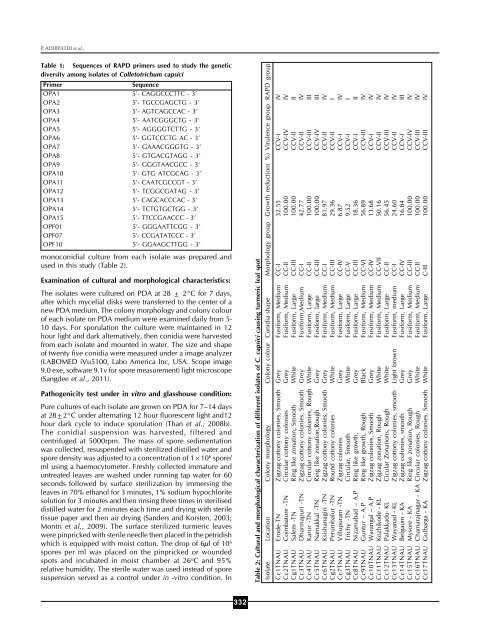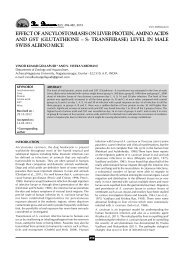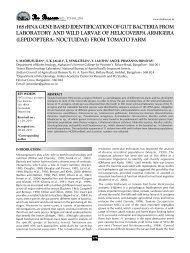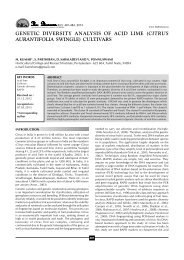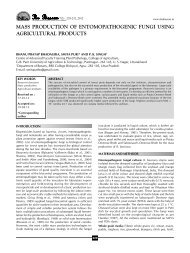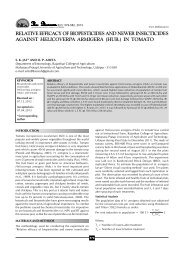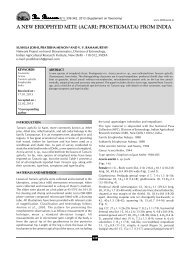Morphological characterization and molecular ... - THE BIOSCAN
Morphological characterization and molecular ... - THE BIOSCAN
Morphological characterization and molecular ... - THE BIOSCAN
- No tags were found...
Create successful ePaper yourself
Turn your PDF publications into a flip-book with our unique Google optimized e-Paper software.
P. ADHIPATHI et al.,Table 1: Sequences of RAPD primers used to study the geneticdiversity among isolates of Colletotrichum capsiciPrimerSequenceOPA1 5’- CAGGCCCTTC - 3’OPA2 5’- TGCCGAGCTG - 3’OPA3 5’- AGTCAGCCAC - 3’OPA4 5’- AATCGGGCTG - 3’OPA5 5’- AGGGGTCTTG - 3’OPA6 5’- GGTCCCTG AC - 3’OPA7 5’- GAAACGGGTG - 3’OPA8 5’- GTGACGTAGG - 3’OPA9 5’- GGGTAACGCC - 3’OPA10 5’- GTG ATCGCAG - 3’OPA11 5’- CAATCGCCGT - 3’OPA12 5’- TCGGCGATAG - 3’OPA13 5’- CAGCACCCAC - 3’OPA14 5’- TCTGTGCTGG - 3’OPA15 5’- TTCCGAACCC - 3’OPF01 5’- GGGAATTCGG - 3’OPF07 5’- CCGATATCCC - 3’OPF10 5’- GGAAGCTTGG - 3’monoconidial culture from each isolate was prepared <strong>and</strong>used in this study (Table 2).Examination of cultural <strong>and</strong> morphological characteristics:The isolates were cultured on PDA at 28 ± 2°C for 7 days,after which mycelial disks were transferred to the center of anew PDA medium. The colony morphology <strong>and</strong> colony colourof each isolate on PDA medium were examined daily from 5-10 days. For sporulation the culture were maintained in 12hour light <strong>and</strong> dark alternatively, then conidia were harvestedfrom each isolate <strong>and</strong> mounted in water. The size <strong>and</strong> shapeof twenty five conidia were measured under a image analyzer(LABOMED iVu5100, Labo America Inc, USA. Scope image9.0 exe, software 9.1v for spore measurement) light microscope(Sangdee et al., 2011).Pathogenicity test under in vitro <strong>and</strong> glasshouse condition:Pure cultures of each isolate are grown on PDA for 7–14 daysat 28±2°C under alternating 12 hour fluorescent light <strong>and</strong>12hour dark cycle to induce sporulation (Than et al., 2008b).The conidial suspension was harvested, filtered <strong>and</strong>centrifuged at 5000rpm. The mass of spore sedimentationwas collected, resuspended with sterilized distilled water <strong>and</strong>spore density was adjusted to a concentration of 1×10 6 spore/ml using a haemocytometer. Freshly collected immature <strong>and</strong>untreated leaves are washed under running tap water for 60seconds followed by surface sterilization by immersing theleaves in 70% ethanol for 3 minutes, 1% sodium hypochloritesolution for 3 minutes <strong>and</strong> then rinsing three times in steriliseddistilled water for 2 minutes each time <strong>and</strong> drying with steriletissue paper <strong>and</strong> then air drying (S<strong>and</strong>ers <strong>and</strong> Korsten, 2003;Montri et al., 2009). The surface sterilized turmeric leaveswere pinpricked with sterile needle then placed in the petridishwhich is equipped with moist cotton. The drop of 6μl of 10 6spores per ml was placed on the pinpricked or woundedspots <strong>and</strong> incubated in moist chamber at 26 o C <strong>and</strong> 95%relative humidity. The sterile water was used instead of sporesuspension served as a control under in -vitro condition. InTable 2: Cultural <strong>and</strong> morphological <strong>characterization</strong> of different isolates of C. capsici causing turmeric leaf spotIsolate Location Colony morphology Colony colour Conidia shape Morphology group Growth reduction( %) Virulence group RAPD groupCc1TNAU Erode-TN Zigzag cottony colonies, Smooth Grey Fusiform, Medium CC-I 32.55 CCV-I IVCc2TNAU Coimbatore -TN Circular cottony colonies Grey Fusiform, Medium CC-II 100.00 CCV-IV IVCg1TNAU Salem -TN Ring like zonation, Smooth White Fusiform, Large CC-III 100.00 CCV-II IICc3TNAU Dharmapuri -TN Zigzag cottony colonies, Smooth Grey Fusiform,Medium CC-I 42.77 CCV-II IVCc4TNAU Karur -TN Circular cottony colonies, Rough White Fusiform, Large CC-II 100.00 CCV-III IIICc5TNAU Namakkal -TN Ring like zonation,Rough Grey Fusiform, large CC-III 100.00 CCV-IV IIICc6TNAU Ksishanagiri -TN Zigzag cottony colonies, Smooth Grey Fusiform, Medium CC-I 81.97 CCV-II IVCg2TNAU Perumbalur -TN Round cottony colonies White Fusiform, Medium CC-III 29.36 CCV-II ICc7TNAU Villupuram -TN Zigzag colonies Grey Fusiform, Large CC-IV 6.87 CCV-I IVCg3TNAU Trichy -TN Circular, Smooth White Fusiform, Large CC-V 9.52 CCV-I ICc8TNAU Nizamabad – A.P Ring like growth, Grey Fusiform, Large CC-III 18.36 CCV-I IICc9TNAU Guntur – A.P Ring like growth, Rough Black Fusiform, Medium CC-VI 56.89 CCV-III IVCc10TNAU Warangal – A.P Zigzag colonies, Smooth Grey Fusiform, Medium CC-IV 13.68 CCV-I IVCc11TNAU Kozhikode - KL Zigzag zonation, Rough White Fusiform, Medium CC-VII 50.16 CCV-II IVCc12TNAU Palakkadu- KL Cicular Zonations, Rough White Fusiform, Large CC-II 56.45 CCV-III IVCc13TNAU Wayanad - KL Zigzag cottony colonies, smooth Light brown Fusiform, medium CC-I 24.60 CCV-II IVCc14TNAU Belgaum - KA Zigzag colonies, smooth Grey Fusiform, Large CC-IV 16.84 CCV-I IIICc15TNAU Mysore - KA Ring like zonation, Rough Grey Fusiform, Medium CC-III 100.00 CCV-IV IVCc16TNAU Chamarajnagar - KA Circular colonies, Rough White Fusiform, Medium CC-II 100.00 CCV-III IVCc17TNAU Gulbarga - KA Zigzag cottony colonies, Smooth White Fusiform, Large C-III 100.00 CCV-III IV332


